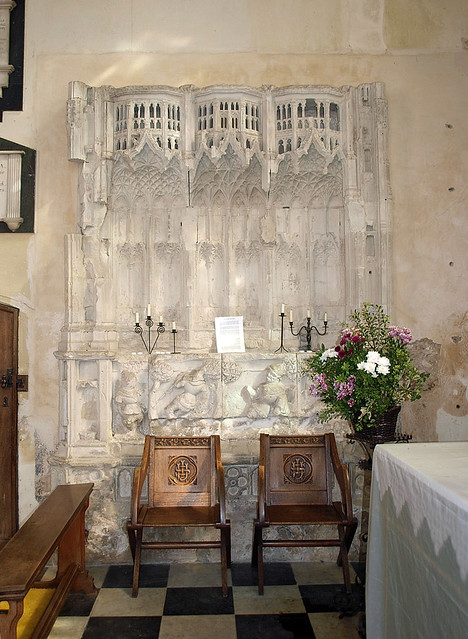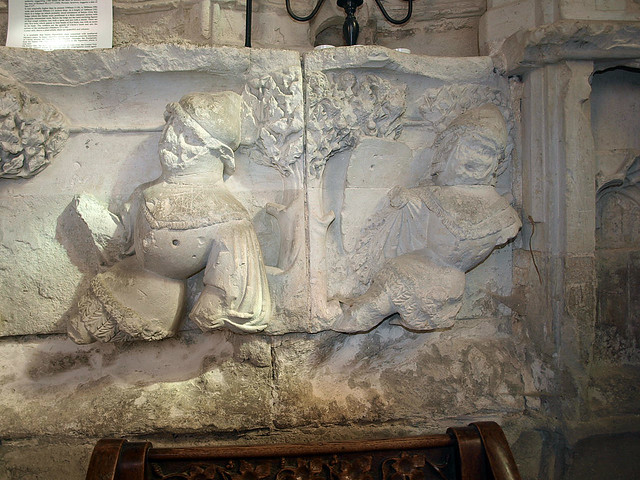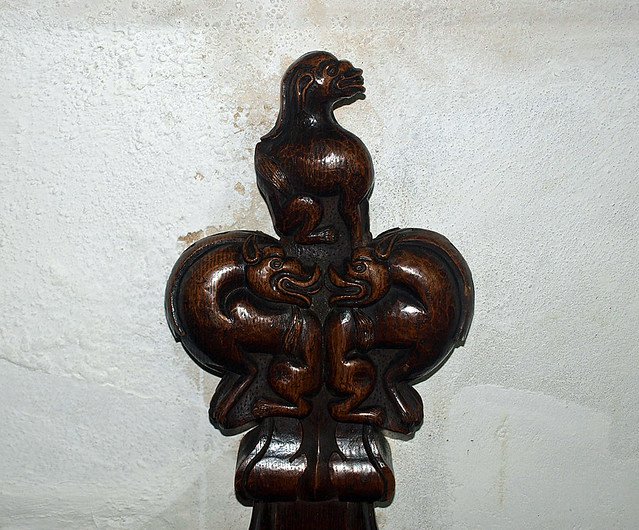ST ANDREW. The story of the church begins with the beautiful arcades, which are mid C13. They have quatrefoil piers looking almost like a cluster of four independent shafts and capitals partly of rich stiff-leaf, partly moulded. The W bay is later, as the arches and responds show, but not later than Dec, which is clear for the mouldings as well as the aisle W windows. This needs stressing; for though they were surely added with a view to the erection of a W tower, the tower itself appears to be Perp throughout. Money was indeed left for its building in 1473. It is an ambitious tower. Diagonal buttresses with flushwork emblems. Such emblems appear also on the base frieze and a frieze above the doorway. Double-stepped battlements with flushwork panelling and eight pinnacles. The aisle and chancel windows are mostly Dec. So is the S porch entrance, but the S doorway belongs to the arcade. The arch mouldings are very varied. Ambitious, somewhat restless clerestory with a commemorative inscription. Three-light windows with knapped-flint surrounds and between them blank straight-headed transomed stone windows. The nave roof has hammerbeams alternating with arched braces starting from wall-posts. The latter stand on big figured stone corbels. The NE vestry is medieval and was originally two-storeyed. - FONT. A big C18 baluster (chancel). - EASTER SEPULCHRE. A very lavish composition of the late C15, unfortunately poorly preserved. Against the tombchest or base seated soldiers in agitated attitudes and little trees separating them. To the l. and r. badly damaged buttresses. Top cresting. The back wall of the shallow recess has busy vaulting in two tiers. - WALL PAINTINGS. In the N aisle; faint. - PLATE. Chalice and Cover, 1568. - MONUMENT. Robert Burhill d. 1727. A wooden tablet, with painted garlands l. and r. - Several good stone tablets.
NORTHWOLD. It lies off the highway, and has many old houses with cream walls and roofs of rich red tiles, a medieval church with flint walls and a 15th-century tower, and the shaft of an old wayside cross. The tower rises in four stages to a handsome crown of battlements and eight pinnacles. A 14th-century porch and a 13th-century doorway leads us to an interior spoiled by galleries along the aisles. The nave arcades are 13th century, the chancel 14th. Crowded with closed pews, the nave looks up to a lovely old oak roof adorned with angels, and resting on stone corbels of angels and grotesques. Its medieval colouring is renewed, the bosses shining with gold, the rafters painted with leaves, and barber’s pole pattern outlining the panels.
The great possession of the church is the 15th-century Easter Sepulchre, among the biggest and best in the land. It is 12 feet high and 9 long, and though sadly battered is still beautiful with a mass of delicate carving in niches and tabernacle work. Its three canopies have lovely traceried vaulting, and below the tomb are sleeping soldiers, battered and broken but recognisable as having been armed, and leaning on trees. On a wooden tablet to Robert Burhill, a profound scholar who was rector here from 1622 till 1641, we read that he “took sanctuary” in the church; he was an intimate friend of Sir Walter Raleigh, and helped him to write his History of the World. Long before his day they laid to rest here John Stalyng, for whose soul our prayers are asked in an inscription on the clerestory outside. His stone coffin is said to be bricked up in the wall.
The great possession of the church is the 15th-century Easter Sepulchre, among the biggest and best in the land. It is 12 feet high and 9 long, and though sadly battered is still beautiful with a mass of delicate carving in niches and tabernacle work. Its three canopies have lovely traceried vaulting, and below the tomb are sleeping soldiers, battered and broken but recognisable as having been armed, and leaning on trees. On a wooden tablet to Robert Burhill, a profound scholar who was rector here from 1622 till 1641, we read that he “took sanctuary” in the church; he was an intimate friend of Sir Walter Raleigh, and helped him to write his History of the World. Long before his day they laid to rest here John Stalyng, for whose soul our prayers are asked in an inscription on the clerestory outside. His stone coffin is said to be bricked up in the wall.



No comments:
Post a Comment